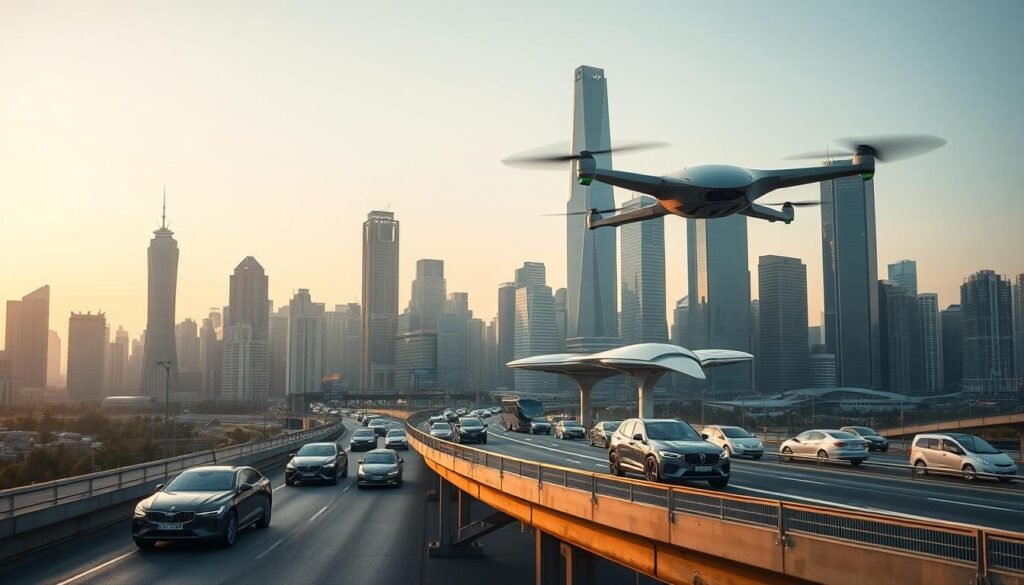As you look to the future, you’re probably wondering: How will artificial intelligence continue to transform industries and revolutionize the way businesses operate? The year 2025 is poised to be a pivotal moment in the evolution of artificial intelligence, with several transformative trends converging to reshape the global economy.
From healthcare to transportation, data-driven intelligence is fundamentally altering how businesses deliver value to customers. The rapid advancement of models and algorithms is creating both unprecedented opportunities and significant challenges that organizations must navigate carefully.
Understanding these emerging trends is crucial for business leaders and professionals seeking to harness the potential of artificial intelligence while addressing concerns around bias and ethical implementation.
Key Takeaways
- The convergence of massive datasets and improved computing power is accelerating AI development.
- Seven key trends will drive innovation and disruption across sectors in 2025.
- Business leaders must navigate challenges around bias and ethical implementation.
- AI is poised to fundamentally alter industries across the global economy.
- Understanding emerging trends is crucial for harnessing AI’s potential.
The Current State of AI and Its Transformative Potential
As we approach 2025, the landscape of artificial intelligence is undergoing significant changes. The transformative potential of AI is becoming increasingly evident across various industries, with healthcare being a prime example.
Traditionally, healthcare has been slow to adopt new technology, but recent trends indicate a rapid shift. According to BDO’s 2024 Healthcare CFO Outlook Survey, a significant majority (98%) of healthcare organizations are already piloting generative AI programs. This surge in AI adoption is not limited to healthcare alone; it’s a precursor to a broader trend across industries.
Defining AI in Today’s Context
In today’s context, AI encompasses a wide range of technologies, from machine learning algorithms to generative AI systems. These technologies are designed to perform tasks that typically require human intelligence, such as data analysis, pattern recognition, and decision-making.
The maturation of AI systems is reaching a critical threshold where their reliability and performance are meeting or exceeding human capabilities in many specialized domains. This advancement is paving the way for AI to become an integral part of various industries.
The Accelerating Pace of AI Innovation
The pace of AI innovation is accelerating rapidly. Several factors are contributing to this acceleration, including advancements in computing power, the availability of large datasets, and improvements in AI algorithms.
| Factor | Description | Impact on AI Innovation |
|---|---|---|
| Computing Power | Advances in hardware and cloud computing | Enables complex AI models to be trained efficiently |
| Data Availability | Increased collection and sharing of data | Improves AI model accuracy and applicability |
| Algorithmic Improvements | Development of more sophisticated AI algorithms | Enhances AI capabilities in various domains |
Why 2025 Will Be a Pivotal Year for AI Adoption
The year 2025 is poised to be a pivotal moment for AI adoption. Several key factors are converging to make this the case. Regulatory frameworks are expected to evolve, providing clearer guidelines for responsible AI implementation. Additionally, the cost barriers to AI adoption are decreasing, making sophisticated AI tools more accessible to organizations of all sizes.
As AI continues to mature and its benefits become more apparent, the competitive advantage gained by early adopters will create market pressure for widespread implementation across industries. The potential economic impact of AI is substantial, with projections suggesting it could reach $15.7 trillion globally by 2030.
Trend 1: Advanced Generative AI Reshaping Content Creation and Design
Generative AI is on the cusp of redefining the creative industry in 2025, offering unprecedented capabilities in content creation and design. This technological advancement is not just about automating tasks; it’s about augmenting human creativity with AI’s ability to generate novel, high-quality content across various formats.
The evolution of generative AI models has been remarkable, transitioning from simple text generation to more complex multimodal capabilities. These next-generation models can now produce not just text, but also images, videos, and even music, thereby expanding their application across different industries.
Beyond Text Generation: Multimodal Generative AI
Multimodal generative AI represents a significant leap forward, enabling the creation of diverse content types. This capability is crucial for industries that rely on varied media formats to engage their audiences. For instance, in marketing, having AI that can generate both compelling text and visually appealing graphics can significantly enhance campaign effectiveness.
Key Features of Multimodal Generative AI:
- Generation of text, images, videos, and audio content
- Ability to understand and process multiple data formats
- Enhanced creativity through the combination of different content types
Industry Applications of Next-Generation Generative Models
The applications of advanced generative AI are vast and varied. In healthcare, for example, AI-generated synthetic data can be used to train models without compromising patient privacy. In entertainment, AI can assist in content creation, such as generating background scores or even helping with scriptwriting.
| Industry | Application | Benefit |
|---|---|---|
| Healthcare | Synthetic data generation for training AI models | Enhanced patient privacy |
| Entertainment | Content creation assistance | Increased productivity |
| Marketing | Personalized content generation | Improved customer engagement |
Challenges and Limitations of Generative AI Systems
Despite their potential, generative AI systems face several challenges. Bias in training data is a significant issue, as it can lead to AI models that perpetuate existing societal prejudices. Moreover, the “black box” nature of many AI models makes it difficult to understand their decision-making processes, raising concerns about accountability and transparency.
To mitigate these risks, organizations must develop robust governance frameworks. This includes ensuring diverse and representative training data, implementing mechanisms for detecting bias, and maintaining transparency in AI decision-making processes.
The future of generative AI is promising, but it requires careful management to realize its benefits while minimizing its risks.
Trend 2: AI in Healthcare: Personalized Medicine and Advanced Diagnostics
As we move into 2025, AI’s role in healthcare is becoming increasingly pivotal, transforming diagnostics and treatment plans. The healthcare sector is witnessing a significant shift towards personalized medicine, driven by AI’s ability to analyze vast amounts of data and provide insights that were previously unimaginable.
AI-Powered Medical Imaging and Diagnostic Algorithms
AI-powered medical imaging is enhancing diagnostic accuracy by analyzing images with a level of detail that surpasses human capability. These advanced algorithms can detect anomalies in X-rays, MRIs, and CT scans, assisting radiologists in making more accurate diagnoses. For instance, AI systems can be trained to identify early signs of diseases such as cancer, allowing for timely intervention.
The use of AI in diagnostics is not limited to image analysis. AI algorithms can process large datasets, including patient histories and genetic information, to identify patterns that may elude human clinicians. This capability is particularly valuable in diagnosing complex conditions that require the analysis of multiple factors.
Drug Discovery and Development Acceleration
AI is also accelerating the process of drug discovery and development. By analyzing vast amounts of biochemical data, AI can identify potential drug candidates and predict their efficacy and safety. This not only speeds up the development process but also reduces the costs associated with bringing new drugs to market.
Moreover, AI can help personalize treatment plans by analyzing patient data to determine the most effective treatment strategies. This approach is particularly relevant in the context of precision medicine, where treatments are tailored to individual patients based on their unique genetic profiles.
Precision Medicine and Personalized Treatment Plans
Precision medicine is becoming increasingly important as healthcare moves towards more personalized care. AI plays a crucial role in this shift by analyzing genomic data and other relevant information to develop targeted treatment plans. This approach not only improves health outcomes but also reduces the risk of adverse reactions by ensuring that treatments are tailored to individual patients.
For example, AI can help identify specific genetic mutations that are driving a patient’s cancer. This information can then be used to develop a personalized treatment plan that targets those mutations, leading to more effective care.
Addressing Healthcare Disparities Through AI
AI has the potential to address healthcare disparities by analyzing population-level data to detect patterns of inequitable care and outcomes. Advanced algorithms can help identify underserved populations and optimize resource allocation to improve access to quality care in disadvantaged communities.
- AI-powered translation and cultural adaptation tools can reduce language and cultural barriers in healthcare settings.
- Remote monitoring and telehealth platforms enhanced by AI can extend specialized care to rural and underserved areas.
- Bias detection tools can continuously monitor clinical decision support systems to identify and mitigate algorithmic bias.
However, it is crucial to ensure that AI solutions are designed and implemented in a way that avoids exacerbating existing healthcare disparities. This requires careful human oversight and a commitment to addressing the ethical challenges associated with AI in healthcare.
By leveraging AI in a responsible and equitable manner, healthcare organizations can improve health outcomes, enhance patient experiences, and reduce disparities in care.
Trend 3: Autonomous AI Systems in Transportation and Manufacturing
Autonomous AI systems are on the cusp of a breakthrough in transportation and manufacturing, marking a significant trend in 2025. This development is expected to bring about substantial improvements in efficiency, productivity, and safety across these industries.
Self-Driving Vehicles and Smart Transportation Networks
The transportation sector is poised for a significant transformation with the advent of self-driving vehicles and smart transportation networks. Artificial intelligence is at the heart of this change, enabling vehicles to navigate complex road scenarios without human intervention. These AI-powered vehicles will not only enhance safety but also reduce traffic congestion and improve fuel efficiency.
Smart transportation networks will further augment the capabilities of self-driving vehicles by providing real-time data on traffic conditions, road closures, and weather. This integration of AI systems with transportation infrastructure will create a seamless and efficient travel experience.

AI-Driven Automation in Manufacturing and Supply Chains
In manufacturing, AI-driven automation is set to revolutionize production processes and supply chain management. By leveraging artificial intelligence, manufacturers can predict maintenance needs, optimize production workflows, and improve product quality. This not only enhances productivity but also reduces costs and minimizes waste.
- Predictive maintenance will become more accurate, reducing downtime and increasing overall equipment effectiveness.
- AI-powered quality control systems will detect defects earlier, improving product reliability and customer satisfaction.
- Supply chain optimization will enable real-time tracking and management of inventory, reducing lead times and improving responsiveness to demand fluctuations.
Human-AI Collaboration in Industrial Settings
The future industrial workplace will be characterized by human-AI collaboration, where systems are designed to work in tandem with human workers. This collaboration will leverage the strengths of both humans and AI, enhancing productivity while ensuring safety.
To achieve effective human-AI collaboration, it is crucial to provide training for both human professionals and AI systems. This will enable them to work together seamlessly, with humans focusing on complex decision-making and AI handling repetitive or physically demanding tasks.
By embracing this collaborative approach, industries can create new roles that combine human judgment, creativity, and dexterity with AI’s computational power and consistency, leading to enhanced productivity and innovation.
Trend 4: AI Ethics and Bias Mitigation Frameworks
With AI increasingly influencing decision-making processes, developing robust ethics frameworks has become a critical priority. As artificial intelligence continues to evolve, it’s essential to address the ethical concerns and potential biases associated with these systems to ensure they serve the greater good.
The future of AI in healthcare, for instance, depends on organizations maintaining a human element in the loop to ensure responsible usage. By instituting a responsible, human-driven AI program, organizations can stay ahead of regulatory changes that are likely to focus on requiring oversight of AI use.
The Growing Importance of Ethical AI Development
The development of artificial intelligence that is both ethical and unbiased is becoming increasingly important. As AI systems begin to make decisions that impact people’s lives, the need for transparency and accountability grows. Ethical AI development involves considering the potential risks and issues associated with these systems.
One of the key issues is the potential for bias in AI systems. If the data used to train AI models is biased, the resulting decisions can perpetuate and even amplify these biases. Therefore, it’s crucial to develop strategies for detecting and mitigating bias.
Regulatory Approaches to AI Ethics
Regulatory bodies are beginning to take notice of the need for AI ethics frameworks. Governments and organizations are exploring ways to regulate AI development and deployment, ensuring that these technologies are used responsibly. This includes implementing oversight mechanisms to monitor AI decision-making processes.
For example, regulatory requirements may mandate specific forms of human oversight for certain AI applications. This could involve professionals reviewing AI-generated recommendations to ensure they are fair and unbiased.
Techniques for Detecting and Mitigating Algorithmic Bias
Detecting and mitigating algorithmic bias is a complex task that requires a multifaceted approach. This involves testing AI systems for bias, using techniques such as auditing and fairness metrics. It also requires ongoing monitoring to ensure that AI decisions remain fair and unbiased over time.
The Role of Human Oversight in AI Decision-Making
Human oversight is critical in ensuring that AI systems are used responsibly. By implementing tiered oversight models, organizations can ensure that routine, low-risk decisions are automated while higher-risk decisions require varying levels of human review and approval.
Effective oversight depends on thoughtfully designed interfaces that present AI recommendations along with relevant context, confidence levels, and explanations. This enables meaningful human evaluation and helps to mitigate the risks associated with AI systems.
Trend 5: AI-Powered Data Privacy and Security Solutions
AI-powered solutions are revolutionizing the way organizations approach data privacy and security. As AI continues to transform industries, it also presents new challenges and opportunities for protecting sensitive information. The need for robust data protection measures has never been more pressing, with organizations facing increasing risks from cyber threats and data breaches.
In response to these challenges, organizations are turning to AI-driven solutions to enhance their data privacy and security posture. By leveraging AI, companies can improve their ability to detect and respond to potential security threats in real-time.
Privacy-Preserving AI Techniques
One of the key trends in AI-powered data privacy and security is the development of privacy-preserving AI techniques. These techniques enable organizations to harness the power of AI while minimizing the risks associated with data exposure. Some of the approaches being explored include:
- Implementing comprehensive data governance frameworks that enable innovation while ensuring compliance with an increasingly complex landscape of privacy regulations.
- Integrating privacy-by-design approaches into development processes, with privacy considerations addressed from the earliest stages of AI projects.
- Developing sophisticated data minimization strategies that collect and retain only the information necessary for specific, well-defined purposes.

AI in Cybersecurity Defense and Threat Detection
AI is also being used to enhance cybersecurity defense and threat detection capabilities. By analyzing vast amounts of data, AI-powered systems can identify patterns and anomalies that may indicate potential security threats. This enables organizations to respond quickly and effectively to emerging threats.
| AI Application | Benefits | Impact |
|---|---|---|
| Automated Compliance Tools | Continuous monitoring of data usage | Reduced risk of regulatory violations |
| Risk-Based Approaches | Appropriate allocation of resources | Enhanced data protection |
| Data Protection Impact Assessments | Early identification of privacy risks | Mitigation of potential issues |
Balancing Innovation with Data Protection Compliance
As organizations adopt AI-powered solutions, they must also ensure that they are complying with relevant regulations and protecting sensitive data. This requires a balanced approach that prioritizes both innovation and data protection compliance. By implementing robust data governance frameworks and privacy-preserving AI techniques, organizations can achieve this balance and maintain public trust.
Trend 6: Ambient Intelligence and Seamless AI Integration
Ambient intelligence is emerging as a key trend in 2025, promising to make AI more pervasive and intuitive in our daily interactions. This involves creating smart environments where AI is seamlessly integrated into our surroundings, enhancing our experiences through contextual computing and predictive assistance.
AI-Enabled Smart Environments and IoT Ecosystems
The proliferation of Internet of Things (IoT) devices is giving rise to AI-enabled smart environments. These environments are characterized by a network of sensors, actuators, and intelligent systems that work together to create a more responsive and personalized experience for users. For instance, smart homes can adjust lighting and temperature based on the occupants’ preferences and habits.
Key features of AI-enabled smart environments include:
- Integration of various IoT devices to create a cohesive ecosystem
- Use of AI to analyze data from sensors and make predictive decisions
- Enhanced user experience through personalized and contextual services
Contextual Computing and Predictive Assistance
Contextual computing is a critical aspect of ambient intelligence, enabling systems to understand the context in which they are being used. This allows for more accurate and relevant predictions, making the interaction with technology more intuitive. For example, a smart assistant can predict your daily routine and offer suggestions accordingly.
The benefits of contextual computing include:
- Improved user experience through relevant and timely suggestions
- Increased efficiency by automating routine tasks
- Enhanced decision-making capabilities through data analysis
Privacy and Security Considerations in Ambient Intelligence
As ambient intelligence becomes more pervasive, concerns about privacy and security are growing. The collection and analysis of vast amounts of data raise significant risks and concerns. It is essential to address these issues through robust data protection measures and transparent information practices.
Some of the key challenges include:
- Ensuring the security of systems that are increasingly interconnected
- Protecting user data and maintaining privacy
- Mitigating the risks associated with the collection and analysis of sensitive information
To address these challenges, organizations must implement comprehensive security frameworks and adhere to regulatory requirements that ensure the protection of user data. This includes adopting privacy-preserving techniques and ensuring that systems are designed with security in mind from the outset.
Trend 7: Global AI Governance and International Cooperation
The future of artificial intelligence development hinges on the establishment of robust global governance frameworks that balance innovation with responsibility. As AI technologies continue to advance and permeate various aspects of society, the need for international cooperation and standardized regulatory approaches becomes increasingly critical.
Emerging International AI Regulatory Frameworks
By 2025, governance frameworks will increasingly focus on enabling responsible innovation rather than simply restricting potentially harmful applications. This shift recognizes that AI development and ethical considerations are not inherently opposed. Regulatory sandboxes will become more common, allowing companies to test novel AI applications in controlled environments with regulatory oversight and temporary exemptions from certain requirements.
Outcome-based regulation will focus on defining required results rather than prescribing specific technical approaches, giving developers flexibility in how they achieve safety, fairness, and transparency goals. This approach will enable the development of more effective and adaptable regulatory frameworks.
The Role of Organizations Like WHO and EU in AI Governance
Organizations such as the World Health Organization (WHO) and the European Union (EU) will play a crucial role in shaping global AI governance. The WHO has already made recommendations to protect health data, mitigate risks, and regulate the use of AI in healthcare more efficiently through international cooperation and the adoption of harmonized standards.
The EU’s regulatory frameworks can serve as a model and guidance for other organizations, including the WHO, in reforming international health regulations. International cooperation will help prevent regulatory arbitrage, where companies simply relocate development to jurisdictions with less stringent requirements.
| Organization | Role in AI Governance | Key Initiatives |
|---|---|---|
| WHO | Regulating AI in Healthcare | Harmonized Standards for AI in Healthcare |
| EU | Setting Regulatory Precedents | Comprehensive AI Regulatory Frameworks |
Balancing Innovation with Responsible AI Development
Effective global AI governance must balance the need for innovation with the necessity of mitigating risks and addressing challenges associated with AI development. Governance frameworks will increasingly incorporate mechanisms for ongoing stakeholder input, ensuring that regulations remain relevant as technology and applications evolve.
Tiered regulatory approaches will apply different levels of oversight based on risks, allowing lower-risk applications to face fewer regulatory hurdles while ensuring appropriate scrutiny for high-risk uses. The most effective governance models will create positive incentives for responsible development rather than relying solely on penalties for non-compliance.
By adopting these balanced approaches, the global community can harness the potential benefits of AI while minimizing its risks and realizing its vast potential.
Conclusion: Preparing for an AI-Transformed Future
With 2025 on the horizon, the seven AI trends we’ve explored will converge to reshape the global landscape, presenting both opportunities and challenges. As organizations worldwide prepare for this transformation, it’s essential to understand the potential impacts across various industries.
The advancement of artificial intelligence is expected to drive significant changes in content creation, healthcare, transportation, and manufacturing. For instance, generative AI will democratize content creation and design, enabling non-specialists to produce sophisticated outputs. However, this also raises important questions about originality, copyright, and the future of creative professions.
In healthcare, AI-powered diagnostics and personalized medicine will potentially improve outcomes, but will require careful attention to issues of bias, privacy, and the essential human elements of care. The integration of AI in healthcare has the potential to transform the industry, but it also brings risks that healthcare leaders must proactively address to protect their patients and organizations.
As AI continues to evolve, several key considerations will shape its development and deployment. These include:
- The need for robust ethics frameworks and bias mitigation techniques to ensure AI benefits are broadly shared.
- The development of privacy-preserving AI techniques and advanced security systems to address growing concerns about data protection.
- The emergence of ambient intelligence, creating more responsive environments while raising questions about surveillance and user autonomy.
- The evolution of global governance frameworks to balance innovation with necessary protections.
To thrive in this AI-transformed landscape, organizations must proactively prepare by investing in appropriate technology, developing AI literacy throughout their workforce, establishing ethical guidelines, and reimagining business processes. The most successful approaches will view AI not as a replacement for human capabilities, but as a powerful tool for augmenting them, creating new possibilities through the unique combination of human and artificial intelligence.
By understanding these trends and taking proactive steps, you can position your organization to capitalize on the opportunities presented by AI while navigating its challenges. As we move towards 2025 and beyond, the future of AI holds much promise, and being prepared is key to harnessing its potential.



